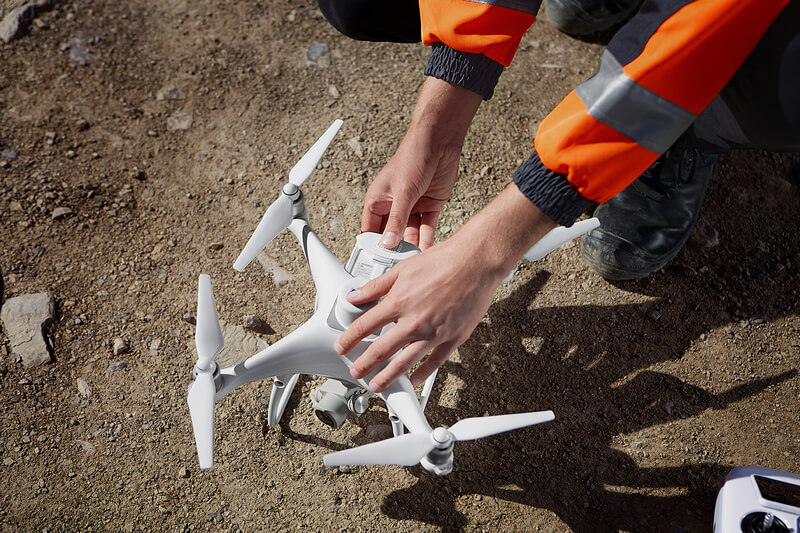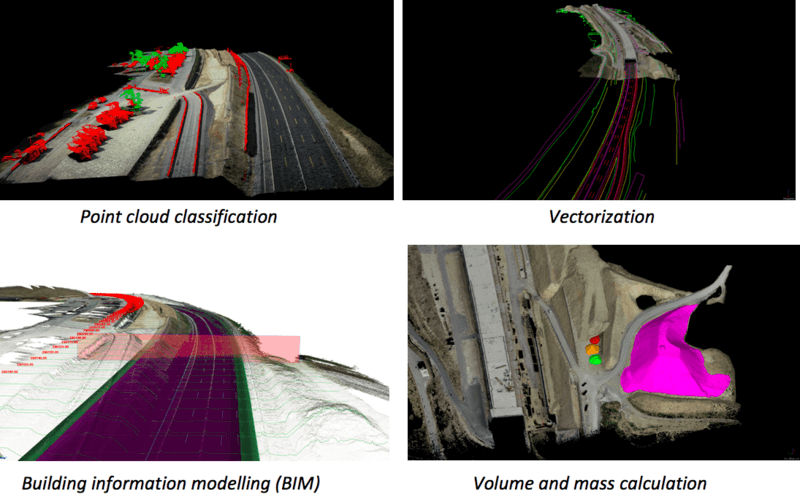The European highway network stretches across 80,000 km and multiple countries. In 2017, Germany ranked second in Europe and forth globally with 12,996 km of highways, making Germany a main transit country for millions of passenger cars and trucks on their way to destinations in Eastern or Southern Europe, creating heavy stress on the existing structures.
The German Federal Ministry of Transport conducted a comprehensive analysis of the expected traffic increase from 2010 until 2030, calculating a rise in passenger-kilometers by 12% and ton-kilometers by 38%.Concluding that there is a critical need for a renewal and extension of the German transportation network, the Ministry recommended a € 270 billion public investment by 2030 in its Federal Transport Infrastructure Plan. Nearly 75% of the investment is meant to cover the renewal and extension of highways and federal roads1.
To match the growing demand for improved transportation infrastructure, teams have looked towards new technologies to increase efficiency. Throughout that process, many contractors have put drones to use on site to create regular site maps and conduct surveying missions faster.
STRABAG – Specialists in Roadwork Construction
Executing the Ministry’s plan is a challenging venture that requires long term planning and coordination of private sector firms and specialists to complete these large scale roadwork construction projects.
STRABAG SE, Europe’s sixth largest construction group, and its German subsidiary STRABAG AG are major players in transport infrastructure construction, which accounts for 37% of STRABAGs output volume. With over 100 years of experience and 70,000+ employees globally, STRABAG has deserved its top market position for good reasons. One is staying ahead on technological innovation.
The STRABAG teams work in parallel on 9,100 construction projects across Europe, with 4,900 of them in Germany. Together, these projects add up to 600 km of highways being constructed or renovated, requiring efficient workflows and communication to keep these projects on time and within budget. Therefore, accurate and precise terrain planning plays a crucial role in managing and ensuring quality of construction projects.

Drone data can accelerate work progress on construction sites
The Digital Object Survey and UAV STRABAG business unit has deployed drones for both internal and external clients to map projects while saving time and costs since 2015. As this technology has been deployed for a growing number of clients, new applications have arisen that demand high accuracy. To address these accuracy needs, STRABAG has added the new Phantom 4 RTK to their surveyors’ toolbox.
The construction of Germany’s A3 highway near the city of Würzburg is one of STRABAG’s current long-term projects. Beginning in 2014 and expected to be completed in 2021, STRABAG is extending the highway from two to three lanes, constructing a new tunnel for soundproofing and replacing a deteriorated bridge, and more2. These improvements are being implemented across multiple kilometers of the highway, over complex terrain with steep slopes and numerous bends. With a large-scale project like Würzburg taking many years, efficient surveying of the site is a high priority for the STRABAG team, enabling them to plan and track progress accurately.
“The use of drones for construction mapping has a lot of advantages. Their integration changes our workflow and simplifies many operational steps. Conventional surveying methods do deliver 3D models as well, but digital terrain models created from drone data provide a higher point density, and therefore reality is portrayed in much higher detail,” says Thomas Gröninger, Head of Business Unit Digital Object Survey and UAV at STRABAG.

With drones, STRABAG is able to create more detailed 3D models in less time
DJI Phantom 4 RTK – A Game Changer for Construction Surveying
Today at STRABAG, drones are a common tool for certain aspects of construction mapping. Drones have proven to be superior to conventional handheld surveying methods in certain environments, such as in projects with low vegetation, GPS availability and substantial sunlight. However, achieving precise surveying results (meaning up to 3 cm accuracy) with a non-RTK/PPK drone requires the placement of up to 40 ground control points (GCP) per square kilometer, which would take several hours.
The new DJI Phantom 4 RTK has a built-in centimeter-level navigation and positioning system and a high-performance imaging system that supports both RTK and PPK solutions. To provide imagery for exceptional surveying deliverables, the Phantom 4 RTK records factory calibrated lenses parameters alongside position, altitude and other data onto each photo, matching the positioning data to the center of the camera’s CMOS sensor using the new TimeSync system. By using the RTK positioning module (GPS L1 L2,GLONASS L1 L2, Galileo E1 E5a and BeiDou B1 B2) the Phantom 4 RTK potentially reduces the required amount of GCPs to 0. For quality management purposes 3-5 GCPs per square kilometer are widely accepted in the industry. When using the Phantom 4 RTK with fewer GCPs, surveyors can achieve a small increase in accuracy and save at least 75% in GCP set-up time.
In order to use all the benefits of the fully integrated system, in RTK Mode surveyors use network RTK services. To achieve even more accurate results, especially in areas with bad mobile network coverage, the D-RTK 2 High Precision GNSS Mobile Station can be connected with ease.
Built for Surveyors
To explain the inner workings of the DJI Phantom 4 RTK in-depth, the drone captures original satellite observation data as well as the ephemeris data and stores it in a PPKRAW.bin file in RTCM 3.2 format. Additionally, the Phantom 4 RTK converts the satellite data on the fly to the RINEX format (Receiver Independent Exchange Format) and writes the data into a RINEX.obs file. Thanks to the internal synchronization of the GNSS position and camera, the Timestamp.MRK file provides a precise recording of the highly accurate image position. All operation-relevant data is stored on a Micro-SD card in a unique folder for each mission. The consistency of the Phantom 4 RTK’s data reduced the time needed to validate the data and results in an efficient post-processing workflow with minimal to no manual adjustments.
Without GCPs, the achievable horizontal accuracy is up to 3cm and vertical accuracy up to 5 cm within the global WGS84 reference network used by the Phantom 4 RTK. In areas that lack mobile network coverage the Phantom 4 RTK allows surveyors to use PPK for subsequent evaluation while keeping the same accuracy provided by RTK.
“When setting up the flight path, we need to select the altitude and overlap. The P4R provides an integrated flight planning app in the remote control including all relevant surveying parameters to make the flight planning easy and efficient,” says Philipp Mielke, Teamleader Business Unit Digital Object Survey and UAV at STRABAG.

The built-in flight planning app simplifies the setting of operational parameters
The Phantom 4 RTK was built to make drone mapping easy, convenient and efficient with the ability to fly for up to 30 minutes, letting users map a large area in one flight. Even if the area is too large to map on a single battery charge, the Operation Resumption function of the GS RTK App automatically resumes the mission after the battery has been replaced. The Phantom 4 RTK saves mappers even more time by flying the mapping plan with curved edges and turning while maintaining a consistent speed. The ability to fly at a consistent height across complex terrain and specific corridor mapping functions are big improvements for surveyors. DJI Mobile SDK enables these features.

If battery change is required for larger mappings, the Phantom 4 RTK resumes the mission automatically
Data Processing
Captured data can easily be integrated into third-party photogrammetry software, delivering industry acceptable point clouds and 3D-models. Philipp Mielke emphasizes that “solutions to upload the drone data from an on-site laptop to the cloud for processing are another step to make on-site surveying innovative. It makes surveyors independent of geographical distances between construction site and their office to permit immediate and powerful data processing.” Visualizing the 3D-model in the cloud shortly after the data was captured allows engineers on site to review the construction work and initialize next steps.
Due to the highly detailed and comprehensive survey data, surveyors and CAD technicians can be sure that they gather all the data in one go without having to return to the construction site to collect additional information, thus saving time. After processing the 3D point cloud from the captured drone photos, the data is post-processed according to the individual project requirements. Typical initial workflows include classification of the point cloud for filtering out unwanted objects such as vegetation, vehicles and artificial objects, feature vectorization and extraction. The processed data is then used for digital terrain and surface modelling, mass and volume calculations, and building information modelling (BIM).
Once processed the Phantom 4 RTK image data can be used to create a variety of deliverables:

In addition to 3D deliverables, 2D orthophotos can be created with third-party software to provide excellent overviews of large construction sites from a bird’s eye view. Both 2D and 3D data is also a good base for pioneering project meetings, driving regular coordination and project reviews.
Drones - Digitizing the Constuction Industry
Drone generated 3D models offer a variety of analysis and evaluation options. Depending on the required accuracy the most common use cases are surveying, inspection, documentation and construction progress monitoring. All of the above are accomplished with drones at the Würzburg construction site.

“STRABAG seeks to expand drone usage for construction projects globally. We currently employ 170 surveyors in Germany and 300 all over Europe. The new DJI Phantom 4 RTK is an easy-to-use and versatile drone with integrated RTK network functionalities. This combination will allow STRABAG to equip more teams with drones to make construction surveying workflows quicker and more efficient,“ Thomas Gröninger summarizes. “The DJI Phantom 4 RTK is an essential addition to the tool box of the surveyor and will take a major role in the process of digitalizing the construction industry.”
Credits to Philipp Mielke, Teamleader Business Unit Digital Object Survey and UAV at STRABAG.
1) Federal Transportation Investment Plan (Bundesverkehrswegeplan)

.png?width=300&name=HS%20-%20Featured%20Images%20(7).png)
-1.png?width=300&name=HS%20-%20Featured%20Images%20(5)-1.png)
.png?width=300&name=Stormpoint%20(1).png)
